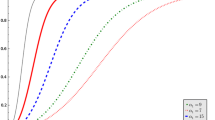Abstract
We consider an operatorial model of alliances between three political parties which interact with their electors, with the undecided voters, and with the electors of the other parties. This extends what was done in a previous paper, where this last type of interactions was not considered. Of course, taking them into account makes the system closer to real life. To produce an exactly solvable model, we restrict here to quadratic Hamiltonians, so that the equations of motion turn out to be linear. The dynamics of the so-called decision functions are deduced, and some explicit situations are considered in details.





Similar content being viewed by others
Notes
Notice that, to simplify the notation, in \(M_j\) and \(R_j\) we are making explicit only the dependence on t.
References
Khrennikov, A.: Ubiquitous Quantum Structure: From Psychology to Finances. Springer, Berlin (2010)
Haven, E., Khrennikov, A.: Quantum Social Science. Cambridge University Press, New York (2013)
Busemeyer, J.R., Bruza, P.D.: Quantum Models of Cognition and Decision. Cambridge University Press, Cambridge (2012)
Asano, M., Ohya, M., Tanaka, Y., Basieva, I., Khrennikov, A.: Quantum-like model of brain’s functioning: decision making from decoherence. J. Theor. Biol. 281, 56–64 (2011)
Asano, M., Ohya, M., Tanaka, Y., Basieva, I., Khrennikov, A.: Quantum-like dynamics of decision-making. Phys. A 391, 2083–2099 (2012)
Khrennikova, P., Haven, E., Khrennikov, A.: An application of the theory of open quantum systems to model the dynamics of party governance in the US Political System. Int. J. Theor. Phys. (2013). doi:10.1007/s10773-013-1931-6
Davis, O.A., Hinich, M.J., Ordeshook, P.: An expository development of a mathematical model of the electoral process. Am. Political Sci. Rev. 64(2), 426–448 (1970)
Buonomo, B., d’Onofrio, A.: Modeling the influence of public’s memory on the corruption-popularity dilemma in politics. J. Optim. Theory Appl. 158, 554–575 (2013)
Makowski, Marcin, Piotrowski, Edward W.: Decisions in elections-transitive or intransitive quantum preferences. J. Phys. A Math. Theor. 44(21), 215303 (2011)
Galam, S.: Sociophysics, A Physicist’s Modeling of Psycho-political Phenomena. Springer, Berlin (2012)
Bagarello, F.: An operator view on alliances in politics. SIAM J. Appl. Math. (SIAP) 75(2), 564–584 (2015)
Bagarello, F., Haven, E.: First results on applying a non-linear effect formalism to alliances between political parties and buy and sell dynamics. Phys. A (In press)
Bagarello, F., Gargano F.: The role of nonlinear interactions in modeling political alliances. Accademia Peloritana dei Pericolanti (In press)
Bagarello, F.: Quantum Dynamics for Classical Systems: With Applications of the Number Operator. Wiley, New York (2012)
Acknowledgments
The author acknowledges partial support from Palermo University and from G.N.F.M. of the INdAM. The author also wishes to thank the organizers of the XVIII Wascom Conference for their financial and logistic support during the conference.
Author information
Authors and Affiliations
Corresponding author
Rights and permissions
About this article
Cite this article
Bagarello, F. An improved model of alliances between political parties. Ricerche mat 65, 399–412 (2016). https://doi.org/10.1007/s11587-016-0261-4
Received:
Revised:
Published:
Issue Date:
DOI: https://doi.org/10.1007/s11587-016-0261-4




